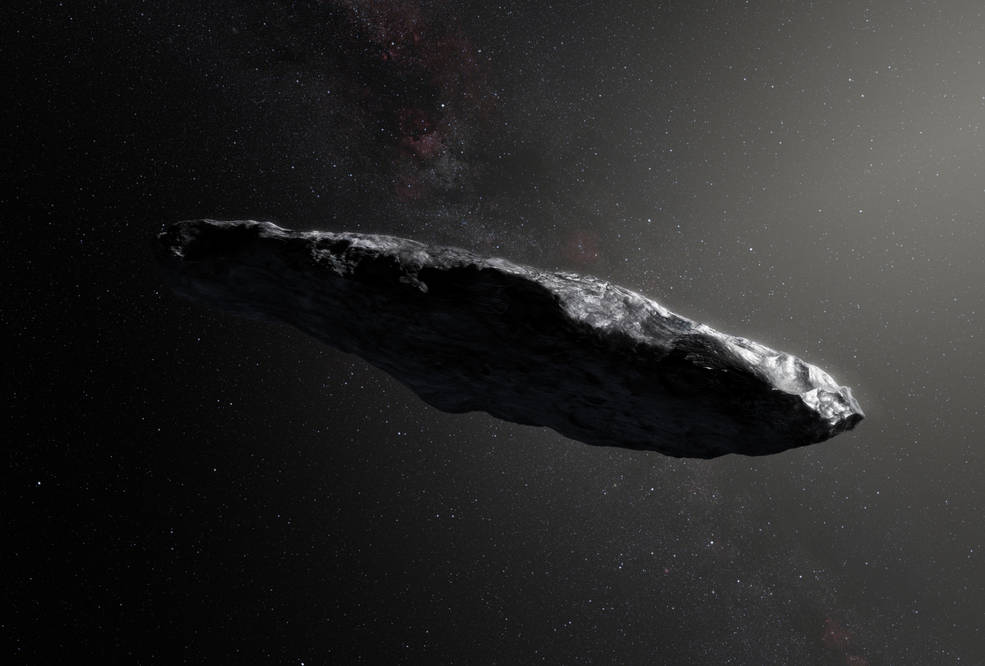The first interstellar object ever seen in our solar system, named ‘Oumuamua, is giving scientists a fresh perspective on the development of planetary systems. A new study by a team including astrophysicists at NASA’s Goddard Space Flight Center in Greenbelt, Maryland, calculated how this visitor from outside our solar system fits into what we know about how planets, asteroids and comets form.

An illustration of ‘Oumuamua, the first object we’ve ever seen pass through our own solar system that has interstellar origins.
Credits: European Southern Observatory/M. Kornmesser
On Sept. 19, ‘Oumuamua sped past the Sun at about 196,000 mph (315,400 km/h), fast enough to escape the Sun’s gravitational pull and break free of the solar system, never to return. Usually, an object traveling at a similar speed would be a comet falling sunward from the outer solar system. Comets are icy objects that range between house-sized to many miles across. But they usually shed gas and dust as they approach the Sun and warm up. ‘Oumuamua didn’t. Some scientists interpreted this to mean that ‘Oumuamua was a dry asteroid.
Planets and planetesimals, smaller objects that include comets and asteroids, condense out of disks of dust, gas and ice around young stars. Smaller objects that form closer to their stars are too hot to have stable surface ice and become asteroids. Those that form farther away use ice as a building block and become comets. The region where asteroids develop is relatively small.
“The total real estate that’s hot enough for that is almost zero,” said lead author Sean Raymond, an astrophysicist at the French National Center for Scientific Research and the University of Bordeaux. “It’s these tiny little circular regions around stars. It’s harder for that stuff to get ejected because it’s more gravitationally bound to the star. It’s hard to imagine how ‘Oumuamua could have gotten kicked out of its system if it started off as an asteroid.”
The distance from a star beyond which water stays ice, even if it’s exposed to sunlight, is called the snow line or ice line. In our own solar system, for example, objects that developed within three times the distance between the Sun and Earth would have been so hot that they lost all their water. That snow line contracted a little as the Sun shrank and cooled over time, but our main belt asteroids are located within or near our snow line — close enough to the Sun that it would be difficult to be ejected.
“If we understand planet formation correctly, ejected material like ‘Oumuamua should be predominantly icy,” said Thomas Barclay, an astrophysicist at Goddard and the University of Maryland, Baltimore County. “If we see populations of these objects that are predominantly rocky, it tells us we’ve got something wrong in our models.”
Scientists suspect most ejected planetesimals come from systems with giant gas planets. The gravitational pull of these massive planets can fling objects out of their system and into interstellar space. Systems with giant planets in unstable orbits are the most efficient at ejecting these smaller bodies because as the giants shift around, they come into contact with more material. Systems that do not form giant planets rarely eject material. [...]
This is articel from nasa.gov (nasa official website)
Article link: https://www.nasa.gov/feature/goddard/2018/new-study-shows-what-interstellar-visitor-oumuamua-can-teach-us
By Jeanette Kazmierczak
Hi! I am a robot. I just upvoted you! I found similar content that readers might be interested in:
https://www.sciencedaily.com/releases/2018/03/180327102811.htm
Downvoting a post can decrease pending rewards and make it less visible. Common reasons:
Submit
Thank you !
Downvoting a post can decrease pending rewards and make it less visible. Common reasons:
Submit